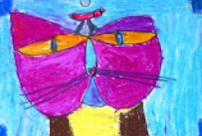Paul Klee Cat And Bird
Learning Targets
I can...
- Create can original Paul Klee Cat And Bird using drawing techniques learned in class
- Use line types (horizontal, vertical, diagonal), shape variation (geometric, organic, free form), and space (positive, negative) inspired by Swiss Artist (1879-1940) Paul Klee
- Use design principle: balance (symmetrical, asymmetrical) and design principles (composition, variation, proportion) based on Expressionism
- Define Interpretations (giving an explanation of the meaning behind a creative work)
Lesson One
Day One, Art Start
1. Cat And Bird (1928) Paul Klee
2. Read The Cat And Bird: A Children's Story Book Inspired by Paul Klee by Geraldine Elschner
3. Discussion Questions "What are primary colors? What are secondary colors? How does Paul Klee use color in his artwork? What do they notice about the way the cat's head is depicted? What shapes can they identify within the head? What do they notice about the colors Klee has used? What colors are they and how are they arranged? What does the bird represent in this picture? What is the cat thinking about? What other things might a cat think about? What do you think this painting called Cat and Bird?"
Lesson Activities
1. Choose 12" by 15" Drawing Paper
2. Add shape variation (geometric, organic, free form) to positive space (cat) of cat drawings
3. Add shape variation (geometric, organic, free form) to negative space (background) of Paul Klee Cat And Bird
Day Two, Art Start
1. Retrieve Paul Klee Cat And Bird from Assigned Table
2. Castle And Sun (1928) Paul Klee
3. Discussion Questions "Why do you think the artist named this artwork Cat and Bird? Does it make you laugh? Why? What is the cat's head made of? Which shapes do you see? What colors did Klee use? Is there anything special about the relationship between these colors? What does it mean when colors are complementary? Which colors in the color wheel are complementary? Why do you think there is a bird in the middle of the cat's head? What else do you think a cat can think about? Did students design their cat out of basic shapes? Did students use complementary colors in their designs?"
Lesson Activities
1. Use analogous colors (orange yellow green) to fill in the positive space (cat) of the cat drawings
2. Use analogous colors (red orange yellow) to fill in the negative space (background) of the cat drawings
3. Add details (whiskers, bird, nose mouth) to positive space (cat) of the Paul Klee Cat And Bird
Day Three, Art Start
1. Retrieve Paul Klee Cat And Bird for Assigned Tables
2. Set Up Studio Area (construction paper, chalk, oil pastels)
Lesson Activities
1. Add highlights (reflective light, light source) to fill in positive space (cat) of cat drawings
2. Add shadows (cast shadow, reflective shadow) to fill in the negative space (background) of cat drawings
3. Add details (animal, facial expressions, spots) to positive space (cat) of Paul Klee Cat And Bird






























